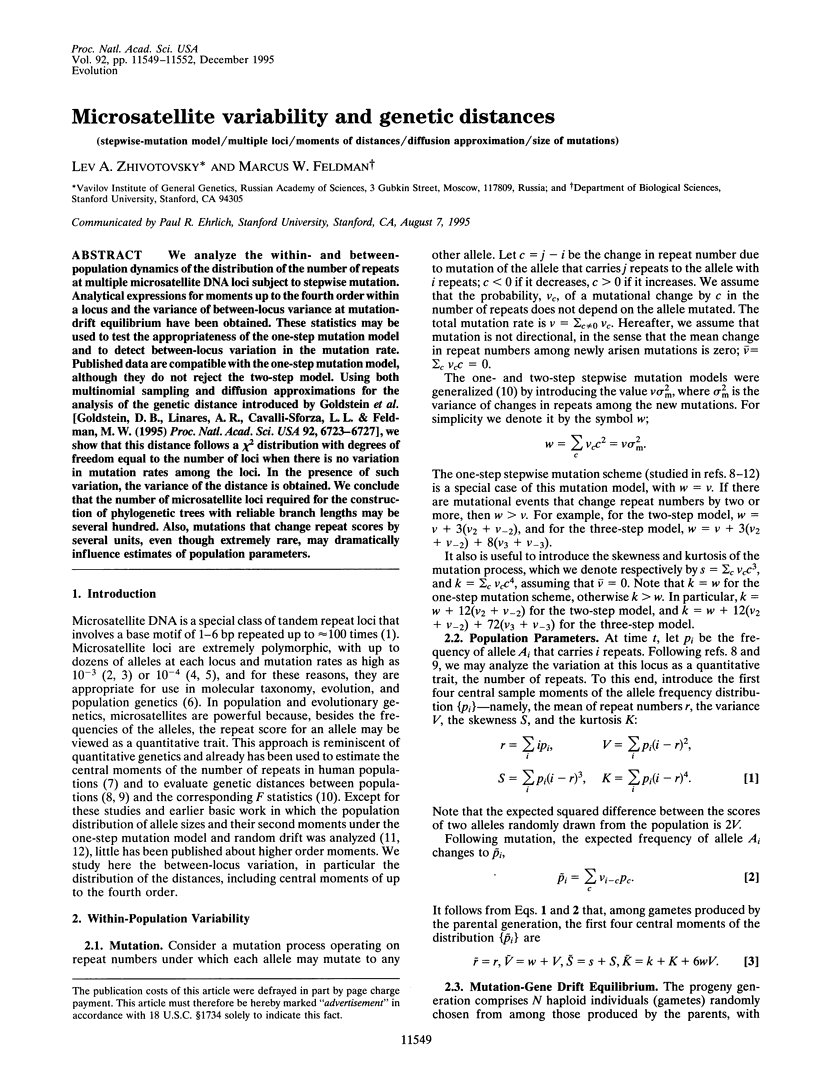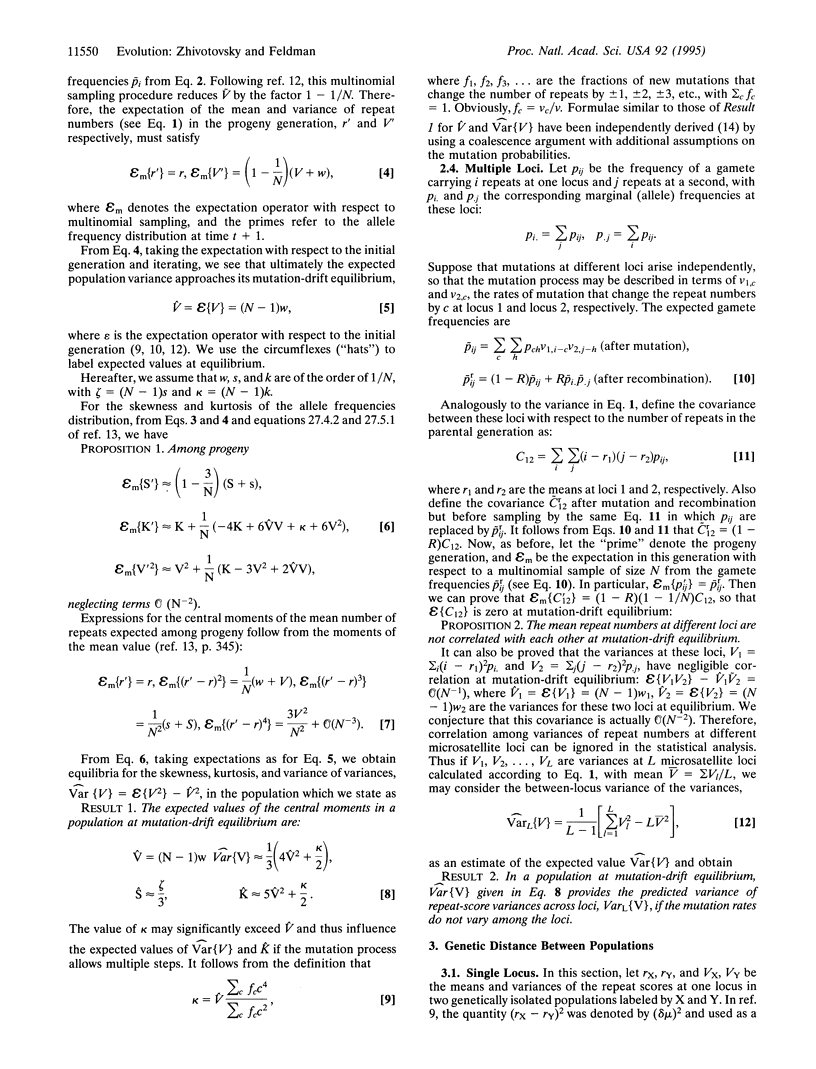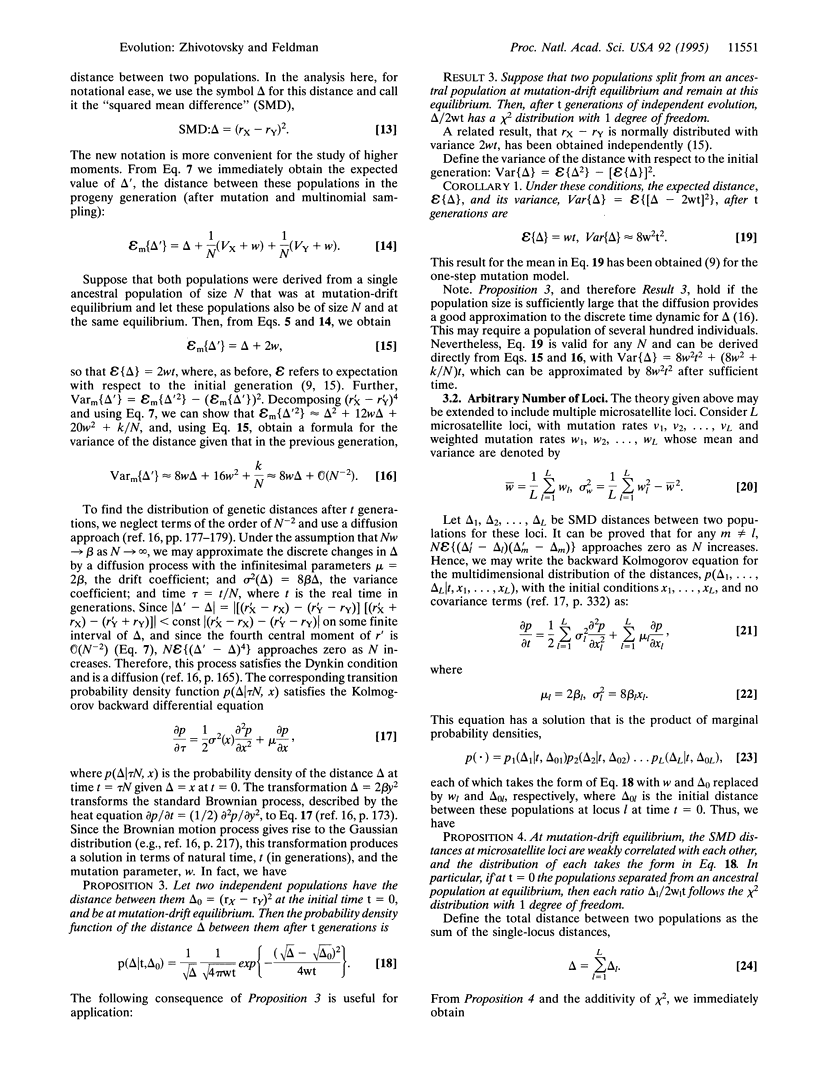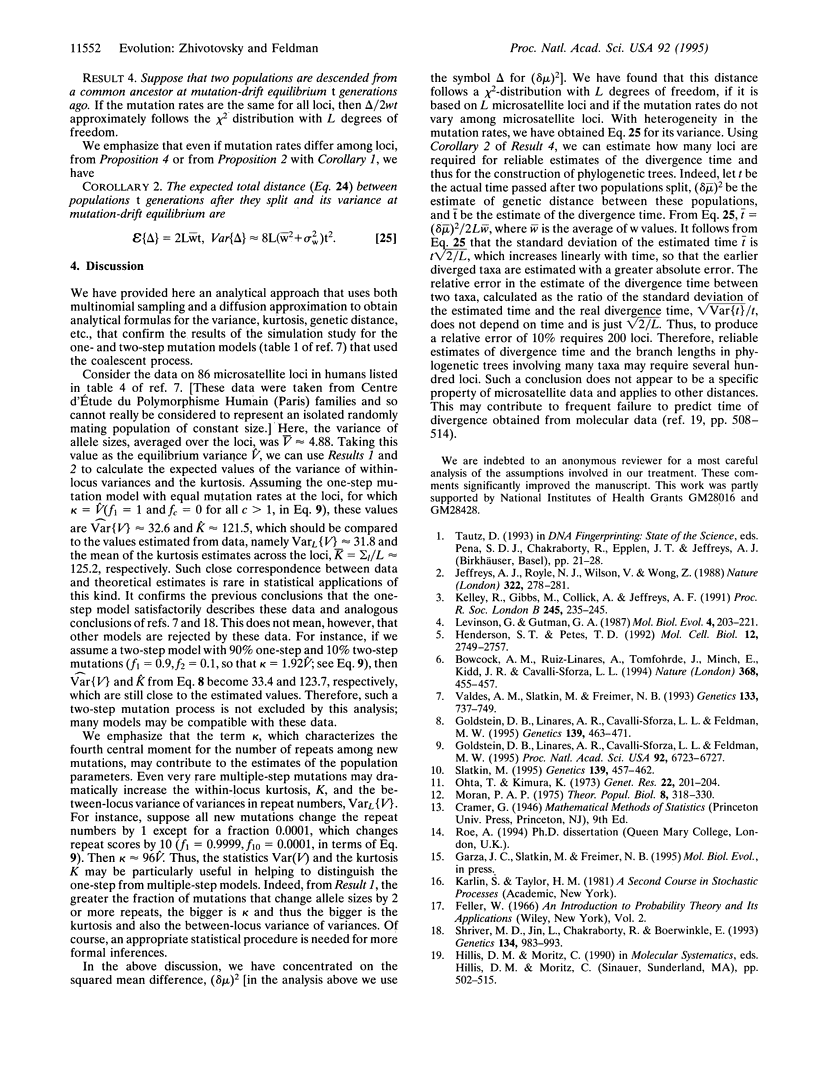Abstract
We analyze the within- and between-population dynamics of the distribution of the number of repeats at multiple microsatellite DNA loci subject to stepwise mutation. Analytical expressions for moments up to the fourth order within a locus and the variance of between-locus variance at mutation-drift equilibrium have been obtained. These statistics may be used to test the appropriateness of the one-step mutation model and to detect between-locus variation in the mutation rate. Published data are compatible with the one-step mutation model, although they do not reject the two-step model. Using both multinomial sampling and diffusion approximations for the analysis of the genetic distance introduced by Goldstein et al. [Goldstein, D. B., Linares, A. R., Cavalli-Sforza, L. L. & Feldman, M. W. (1995) Proc. Natl. Acad. Sci. USA 92, 6723-6727], we show that this distance follows a chi 2 distribution with degrees of freedom equal to the number of loci when there is no variation in mutation rates among the loci. In the presence of such variation, the variance of the distance is obtained. We conclude that the number of microsatellite loci required for the construction of phylogenetic trees with reliable branch lengths may be several hundred. Also, mutations that change repeat scores by several units, even though extremely rare, may dramatically influence estimates of population parameters.
Full text
PDF



Selected References
These references are in PubMed. This may not be the complete list of references from this article.
- Bowcock A. M., Ruiz-Linares A., Tomfohrde J., Minch E., Kidd J. R., Cavalli-Sforza L. L. High resolution of human evolutionary trees with polymorphic microsatellites. Nature. 1994 Mar 31;368(6470):455–457. doi: 10.1038/368455a0. [DOI] [PubMed] [Google Scholar]
- Goldstein D. B., Ruiz Linares A., Cavalli-Sforza L. L., Feldman M. W. An evaluation of genetic distances for use with microsatellite loci. Genetics. 1995 Jan;139(1):463–471. doi: 10.1093/genetics/139.1.463. [DOI] [PMC free article] [PubMed] [Google Scholar]
- Goldstein D. B., Ruiz Linares A., Cavalli-Sforza L. L., Feldman M. W. Genetic absolute dating based on microsatellites and the origin of modern humans. Proc Natl Acad Sci U S A. 1995 Jul 18;92(15):6723–6727. doi: 10.1073/pnas.92.15.6723. [DOI] [PMC free article] [PubMed] [Google Scholar]
- Henderson S. T., Petes T. D. Instability of simple sequence DNA in Saccharomyces cerevisiae. Mol Cell Biol. 1992 Jun;12(6):2749–2757. doi: 10.1128/mcb.12.6.2749. [DOI] [PMC free article] [PubMed] [Google Scholar]
- Jeffreys A. J., Royle N. J., Wilson V., Wong Z. Spontaneous mutation rates to new length alleles at tandem-repetitive hypervariable loci in human DNA. Nature. 1988 Mar 17;332(6161):278–281. doi: 10.1038/332278a0. [DOI] [PubMed] [Google Scholar]
- Kelly R., Gibbs M., Collick A., Jeffreys A. J. Spontaneous mutation at the hypervariable mouse minisatellite locus Ms6-hm: flanking DNA sequence and analysis of germline and early somatic mutation events. Proc Biol Sci. 1991 Sep 23;245(1314):235–245. doi: 10.1098/rspb.1991.0115. [DOI] [PubMed] [Google Scholar]
- Levinson G., Gutman G. A. Slipped-strand mispairing: a major mechanism for DNA sequence evolution. Mol Biol Evol. 1987 May;4(3):203–221. doi: 10.1093/oxfordjournals.molbev.a040442. [DOI] [PubMed] [Google Scholar]
- Moran P. A. Wandering distributions and the electrophoretic profile. Theor Popul Biol. 1975 Dec;8(3):318–330. doi: 10.1016/0040-5809(75)90049-0. [DOI] [PubMed] [Google Scholar]
- Ohta T., Kimura M. A model of mutation appropriate to estimate the number of electrophoretically detectable alleles in a finite population. Genet Res. 1973 Oct;22(2):201–204. doi: 10.1017/s0016672300012994. [DOI] [PubMed] [Google Scholar]
- Shriver M. D., Jin L., Chakraborty R., Boerwinkle E. VNTR allele frequency distributions under the stepwise mutation model: a computer simulation approach. Genetics. 1993 Jul;134(3):983–993. doi: 10.1093/genetics/134.3.983. [DOI] [PMC free article] [PubMed] [Google Scholar]
- Slatkin M. A measure of population subdivision based on microsatellite allele frequencies. Genetics. 1995 Jan;139(1):457–462. doi: 10.1093/genetics/139.1.457. [DOI] [PMC free article] [PubMed] [Google Scholar]
- Valdes A. M., Slatkin M., Freimer N. B. Allele frequencies at microsatellite loci: the stepwise mutation model revisited. Genetics. 1993 Mar;133(3):737–749. doi: 10.1093/genetics/133.3.737. [DOI] [PMC free article] [PubMed] [Google Scholar]


